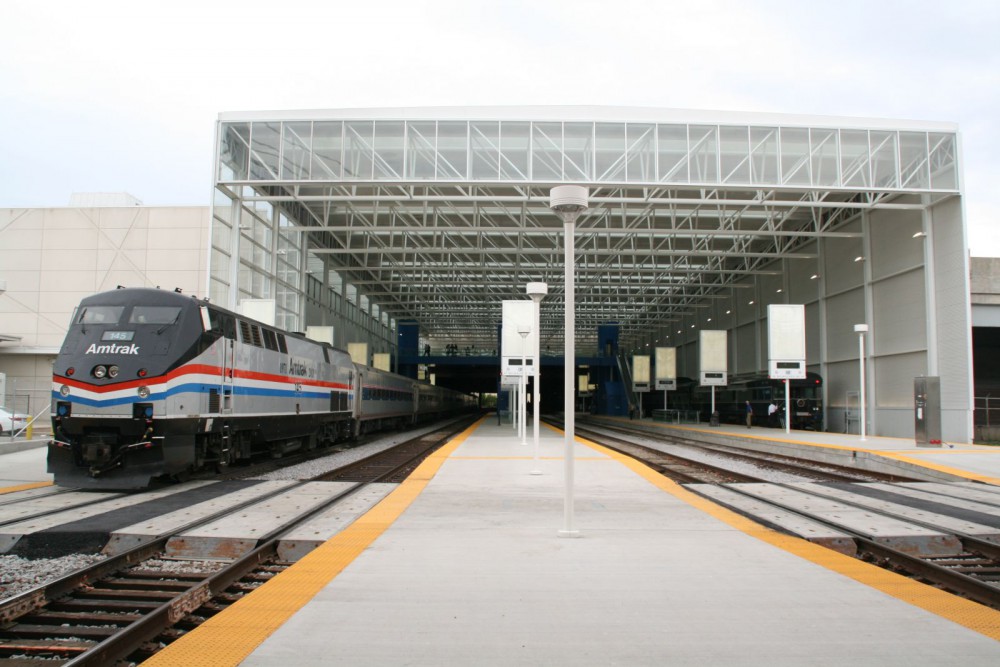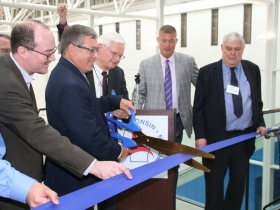New $22 Million Rail Concourse Opens
Intermodal Station's dark and dingy concourse for boarding trains finally replaced.
“Today is a great day for Wisconsin, a great day for the Milwaukee area and a great day for the Wisconsin Department of Transportation” proclaimed WisDOT secretary Mark Gottlieb at the ribbon cutting for the Milwaukee Intermodal Station‘s new $22 million passenger concourse and train shed. The station opened to great fanfare in 2007, replacing a dilapidated 1960s Amtrak station originally built by the defunct Milwaukee Road with a new glassy facility with an open ticketing and waiting area. The new station hid a secret, though, what Gottlieb called a “dark and dingy 50-year-old concourse,” that forced riders to board trains in what felt like a factory. Starting today, the front of the house finally matches the back with riders boarding trains in a well-lit, airy facility.
Designed by Hanno Weber & Associates of Chicago, construction on the project began in January 2015. Janesville-based J.P. Cullen served as the general contractor on the project, with Benesch and GRAEF providing engineering support. Attached to the south side of the station at 433 W. St. Paul Ave., the structure is 400-feet long, 121-feet wide and 56-feet tall from ground to rooftop.
The new concourse features escalators, elevators and stairs to get passengers up to a mezzanine level in a way that is fully accessible to those with disabilities. The project itself was mandated not by the need for a better looking entryway to the city, but because the prior concourse was far from compliant with Americans with Disabilities Act requirements.
The platforms are used by seven Amtrak Hiawatha Service trains a day, as well as two Amtrak Empire Builder trains. While substantially more active than many Midwestern train stations, the station has the capacity to see substantially more traffic if the Hiawatha Service is ever extended or the Kenosha-Racine-Milwaukee commuter rail project ever gets off the drawing board.
Redevelopment of the train shed isn’t as simple and straight forward as it might seem. In addition to accommodating nearly 600,000 passengers every year, the train shed sits over a very active freight line. The station is owned by the Wisconsin Department of Transportation, but the five tracks through the facility are owned by the Canadian Pacific railroad. The station is leased to and operated by the Milwaukee Intermodal Partners (with office space available for lease). The operator pays property taxes on the building, which allowed the city to use tax-incremental financing to contribute $6 million to the $15 million 2007 renovation.
As if the multiple layers of ownership and management aren’t enough, to get the necessary approvals for the project the state had to work with the Federal Railroad Administration, Federal Transit Administration and Federal Highway Administration.
Despite its complicated history, passenger rail advocates and WisDOT officials were all smiles at the mezzanine ribbon cutting today with well-over 100 people in attendance.
Concourse and Station Photos
Station Becoming Truly Multi-Modal
It’s taken a number of years, but the intermodal station is finally living up to its name. It opened with Greyhound buses, Amtrak trains and a handful of other regional bus lines, but has shown steady growth since then. Bublr Bikes added a dock at the station in 2014 and earlier this year Badger Bus relocated their downtown hub to the station. The Milwaukee Streetcar will stop at the station’s eastern end when service begins in two years. Still in planning, the Milwaukee County Transit System might end up sending a number of routes to the station as part of the demolition of the Downtown Transit Center. All told, an estimated 1.3 million trips began or ended at the Milwaukee Intermodal Station last year.
Increasing Costs and Delays
The state missed numerous opportunities to save millions on the project. The $823 million high-speed rail stimulus grant that would have extended the Hiawatha Service to Madison would have paid for 100 percent of the project cost, but governor Scott Walker pledged to reject the project during his gubernatorial campaign, causing the federal government to withdraw the grant in 2010. Adding insult to injury, the Federal Railroad Administration passed tougher regulations about platform heights in 2011, which substantially increased the project cost because the state failed to get construction underway by the February 2012 cut-off.
Compounding the boarding issues and costs, the state legislature rejected the use of the Milwaukee-built Talgo trainsets which featured lower boarding. Litigation relating to that decision has yet to be resolved, but to-date the state has paid over $50 million for trains it does not own and cannot use. Still in use today are Horizon passenger cars dating back to 1988.
If you’re still with me, the 2010 project cost was $0 and the final cost was $22 million. Ouch. Thankfully the federal government stepped in to cover 50 percent of the bill.
Hiawatha Improvements
Ticking off the recent improvements, secretary Gottlieb said “we’re not just standing still with regard to the service we provide on the Hiawatha.” Wi-fi is available on all trains now. Passengers may now also bring their bikes onto the Hiawatha without disassembly for $5. In addition, small pets are welcome aboard, including cats and small dogs.
A number of summer pilot programs are underway, including the addition of late-night service departing from Chicago at 11:10 p.m. and a south-bound train leaving Milwaukee at 10:40 p.m. Kids 12 and under can ride free this summer on Friday, Saturday and Sunday with the purchase of a paid adult ticket.
New locomotives will also be added to the trains in 2017, which according to Michael Franke of Amtrak promise faster acceleration and better fuel efficiency.
Praising the station improvements, Milwaukee Metropolitan Association of Commerce president Tim Sheehy proclaimed that “great cities have great front doors.” Going on to push for more Hiawatha service, Sheehy stated “let’s add to the seven trains, let’s improve the track to pick up speed between here and Chicago.” How long will we have to wait for it to actually happen?
Ribbon Cutting Photos
Eyes on Milwaukee
-
Church, Cupid Partner On Affordable Housing
 Dec 4th, 2023 by Jeramey Jannene
Dec 4th, 2023 by Jeramey Jannene
-
Downtown Building Sells For Nearly Twice Its Assessed Value
 Nov 12th, 2023 by Jeramey Jannene
Nov 12th, 2023 by Jeramey Jannene
-
Immigration Office Moving To 310W Building
 Oct 25th, 2023 by Jeramey Jannene
Oct 25th, 2023 by Jeramey Jannene



































I popped up from Chicago on the Hiawatha Friday afternoon and returned Sunday evening. The new shed was a noticeable difference and a welcome difference!
nice to have something near by to pass the time. I mean, there’s Stone Creek Coffee Roaster down there, but….
A welcome difference from the shed before. Hiawatha is an excellent way to get to Chicago for a weekend without dealing with the headaches of driving.
Union Station in Chicago could use some sprucing up of it’s platform now. Talk about apocalyptic.
It looks really great! Is there any alternative to taking the escalator to get across the tracks? Elevator or stairs?
I pass through this station a couple of times a month and applaud the improvements, including an elevator to supplement the escalators and the overall bright and colorful design.
I may be the only person in the world who feels this way, but it is too bad that the work completely obliterated the lovely concrete screen with offset porthole openings that used to be just SE of the main building and the extended platform to the West. Both were excellent examples of the mid 20th century architectural response to the adventure of travel. Kind of funky, maybe even a bit kitsch, they were nonetheless worthy of preservation.
Such is the lot of much of mid-century design, too new to be thought of as “historic,” work from this period is often carelessly discarded without regard to design merit.
Response to (3) Andy. There are both stairs and elevators besides the escalators.
From the looks of the Urban Milwaukee photos, there’s much to be commended in the new train shed at Milwaukee’s Hauptbahnhof. Regrettably, for all the simple splendor something was forgotten about the very moment when travelers board and alight from trains. Namely, judging from the photos, not one platform was built at deck level, at the level of the decks within the Hiawatha-service cars. Because the station had to be designed to accommodate Canadian Pacific freight trains passing through the shed, there would have been a need for at least one low-level platform adjacent to two ‘freight friendly’ tracks, accommodating the wider clearances of freight trains (and the lower, entrance decks of Empire Builder passenger cars). But one platform, perhaps two, could have been designed such that no steps would have been required to alight from or board Hiawatha trains. Entering and leaving passenger trains without the necessity of steps is faster, safer, and requires no special provision for accommodating handicapped travelers. Alas, for all the money spent, Milwaukee’s main station continues to fall short, when it could have so easily risen to the occasion of travelers entering or leaving Milwaukee via railway service.